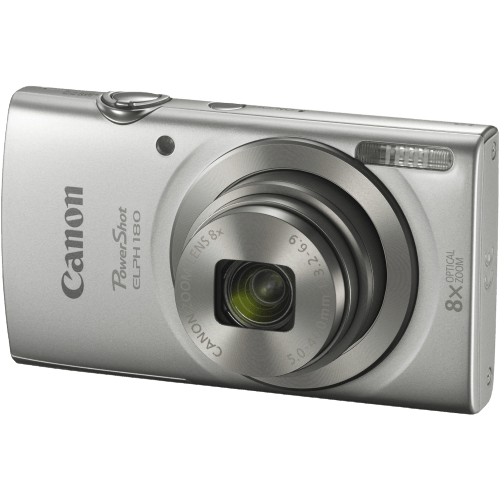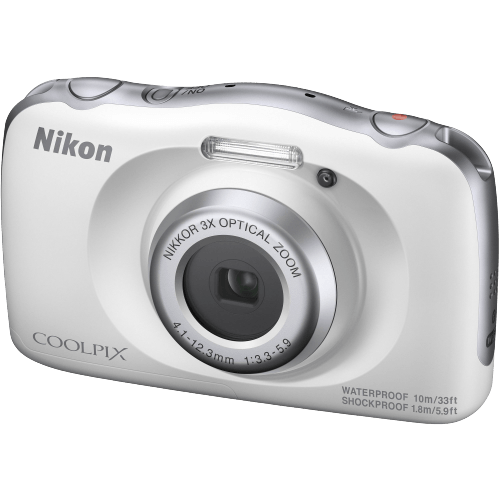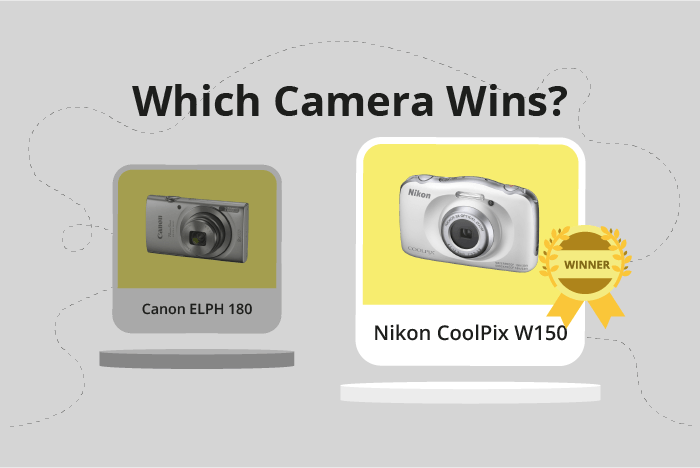Canon PowerShot ELPH 180 vs Nikon CoolPix W150 Comparison
Canon PowerShot ELPH 180

Nikon CoolPix W150

The Nikon CoolPix W150 takes the lead with a score of 51/100, while the Canon PowerShot ELPH 180 trails behind at 46/100. Both cameras are compact and were launched at relatively affordable prices, with the Canon at $120 and the Nikon at $150. They share similar dimensions, but the Nikon is slightly larger at 110 x 67 x 38mm and heavier at 177g, compared to the Canon’s 95 x 54 x 22mm and 126g.
The Nikon CoolPix W150 outperforms the Canon PowerShot ELPH 180 due to its better score, which reflects its superior quality. However, the Canon has its advantages, such as its lighter weight and smaller size, making it more portable and convenient for users on-the-go.
Taking into account their respective scores and specifications, the Nikon CoolPix W150 is the better camera, but the Canon PowerShot ELPH 180 may be more suitable for those who prioritize portability and affordability.
Canon PowerShot ELPH 180 vs Nikon CoolPix W150 Overview and Optics
The Canon PowerShot ELPH 180 wins in optics with a score of 53/100, while the Nikon CoolPix W150 scores 50/100. Both cameras have 1/2.3″ and 1/3.1″ sensor sizes, fixed lens mounts, and image stabilization.
The Canon PowerShot ELPH 180 has a higher megapixel count of 20 compared to the Nikon CoolPix W150’s 13 megapixels. This allows the Canon to capture more details in images. The ELPH 180 also features a CCD sensor and a Digic 4+ processor, with a DXOMARK score of 66, indicating better overall image quality.
On the other hand, the Nikon CoolPix W150 has a higher shooting speed of 11 compared to the Canon’s 0.8. This makes the Nikon better suited for capturing fast-moving subjects. The W150 also features a CMOS sensor, which generally performs better in low-light conditions, and has a higher DXOMARK score of 72 for the sensor.
While the Canon PowerShot ELPH 180 offers higher resolution images and better overall image quality, the Nikon CoolPix W150 provides faster shooting speeds and better low-light performance. The choice between these two cameras depends on individual preferences and intended use. If capturing detailed images is a priority, the Canon PowerShot ELPH 180 is a better choice. However, if shooting fast-moving subjects or in low-light conditions is more important, the Nikon CoolPix W150 may be the preferred option.
Canon PowerShot ELPH 180 vs Nikon CoolPix W150 Video Performance
The Nikon CoolPix W150 outperforms the Canon PowerShot ELPH 180 in video capabilities, scoring 57 out of 100 compared to the ELPH 180’s score of 34. Both cameras share some common video specifications, such as a maximum video frame rate of 30fps. However, the CoolPix W150 excels in other areas, making it the superior choice for video recording.
One significant advantage of the CoolPix W150 is its Full HD video resolution, with maximum dimensions of 1920 x 1080. This is a clear improvement over the ELPH 180’s Standard HD resolution, which offers maximum dimensions of 1280 x 720. The higher resolution in the W150 results in sharper and more detailed video footage.
Another noteworthy feature of the CoolPix W150 is its built-in time-lapse functionality. This allows users to create time-lapse videos directly within the camera, without needing additional software or equipment. The ELPH 180 lacks this feature, limiting its creative video options.
While the Canon PowerShot ELPH 180 does not surpass the Nikon CoolPix W150 in any specific video aspect, its lower score does not mean it is entirely inadequate. For casual users who primarily focus on still photography and only occasionally record videos, the ELPH 180 may still be a suitable choice.
Taking all factors into consideration, the Nikon CoolPix W150 is the superior camera for video capabilities, thanks to its Full HD resolution and built-in time-lapse feature. The Canon PowerShot ELPH 180 remains a viable option for those who prioritize still photography and do not require advanced video features.
Canon PowerShot ELPH 180 vs Nikon CoolPix W150 Features and Benefits
The Nikon CoolPix W150 takes the lead in this comparison, scoring 60 out of 100 points in features, while the Canon PowerShot ELPH 180 scores 34 points. Both cameras share a few common specifications, such as a 2.7-inch screen size and 230,000-dot screen resolution. Neither camera offers a touchscreen or flip screen, and both lack GPS functionality. However, they both come with built-in Wi-Fi capabilities.
The Nikon CoolPix W150 outperforms the Canon PowerShot ELPH 180 in terms of connectivity, as it has built-in Bluetooth, which the ELPH 180 lacks. This feature allows for seamless pairing with compatible devices, making it easier to transfer photos and control the camera remotely.
On the other hand, the Canon PowerShot ELPH 180 does not have any significant advantages over the Nikon CoolPix W150. Both cameras share many of the same features, and the Nikon CoolPix W150’s superior score reflects its additional Bluetooth functionality.
In comparing these two cameras, it is clear that the Nikon CoolPix W150 is the better choice, primarily due to its added Bluetooth capabilities. The Canon PowerShot ELPH 180, while sharing many features with the W150, does not offer any notable advantages. Therefore, the Nikon CoolPix W150 is the recommended choice for those seeking a camera with better connectivity and features.
Canon PowerShot ELPH 180 vs Nikon CoolPix W150 Storage and Battery
The Canon PowerShot ELPH 180 and the Nikon CoolPix W150 both score 27/100 in storage and battery. They share identical specs in this category, with each camera having one memory card slot, accepting SD/SDHC/SDXC (UHS-I compatible) cards, and offering USB charging. Both cameras have a battery life of 220 shots, with the ELPH 180 using an NB-11LH battery and the CoolPix W150 using an EN-EL19 battery.
The ELPH 180 does not surpass the CoolPix W150 in storage and battery, as their scores and specs are the same. However, the CoolPix W150 has an advantage in its internal storage, which the ELPH 180 lacks.
Given the identical scores and near-equal specifications, neither camera stands out as the clear winner in storage and battery. The only difference is the internal storage available in the CoolPix W150, making it slightly more versatile in this aspect.
Canon PowerShot ELPH 180 vs Nikon CoolPix W150 – Our Verdict
Are you still undecided about which camera is right for you? Have a look at these popular comparisons that feature the Canon PowerShot ELPH 180 or the Nikon CoolPix W150:

